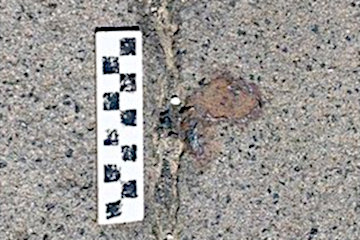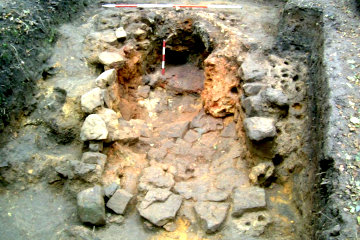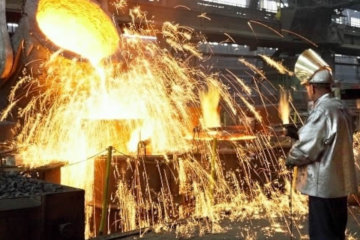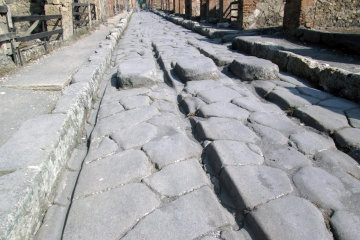The Incredible Iron Roads
King Agrippa once rebuked St Paul for making a statement that appeared to be contrary to the best Greek and Roman science by exclaiming, "Much learning doth make thee mad!" It is an unfortunate fact that someone who is an expert in one field can frequently lack expertise in another field and it would appear that St Paul was not the last person whose learning led to questionable conclusions.

| |
| Iron spatter in a Pompeii street. Unfortunately we are not told the scale, but my guess is that each segment is 1cm. |
A paper recently published in the American Journal of Archaeology reports on the discovery that the streets of Pompeii show 434 spots of iron spatter or staining. Now that is a fact and one that is sufficiently unusual to suggest that further enquiry might be justified. It is the conclusion reached by Eric Poehler, Juliana van Roggen and Benjamin Crowther that brings King Agrippa irresistably to mind.
Their conclusion is that the Romans - or, at least, the Romans in Pompeii - repaired the ruts in their stone roads by pouring molten iron into them! In their learned paper they deal at length with the questions of whether the Romans could melt iron and whether they had sufficient iron for the purpose.
The answer to the first question is that the Romans really could melt iron. This is hardly earth-shattering: Roman swords, armour, shoe studs, cooking pots and wheel rims are available in any museum as proof that the Romans could indeed melt iron.
The answer to the second question is more equivocal. Poehler et al point out that the Romans were exporting some 550 tons of iron annually from the Weald in England, but so far as I can see, they fail to address the question of how much of that iron would be available for road repairs given the need for swords, armour, shoe studs, cooking pots and wheel rims. Given modern patterns of governmental spending, I think it highly likely that swords would take precedence over road repairs!

| |
| The remains of a Roman iron foundry in the Weald of Kent. |
They do point out that Roman extraction methods were inefficient and that 40-70% of the metal remained in the slag. They claim - without evidence, it would appear - that this slag was used as ballast in Roman ships and ended up in Pompeii. What they fail to address is why the smiths of Pompeii should be more efficient than the iron masters of the Weald and be able to extract the metal that the original manufacturers could not.
However let us leave such petty quibbles aside and try to picture these road repairs in operation. A fire hot enough to melt iron would indubitably leave its mark, yet there are no signs of such furnaces dotted along the streets of Pompeii. Poehler therefore suggests that there was a central furnace (not yet found) where the iron was smelted, poured into pots and carried through the streets by slaves to where the repair was needed. This, he claims, is the source of the spatter, which is found even on streets that did not need repairing.
The trouble is that even in the Weald, the best the Romans could achieve was a low-temperature process that does not actually melt the iron but produces a spongy mass called "bloom", which then has to be hammered to produce solid iron. The hammering is what gives the iron its somewhat old-fashioned name of "wrought iron". Heating iron hot enough to melt and pour, thus giving you "cast iron", did not arrive in Europe until the 15th century AD!
Iron melts at 2,800°F or 1,538°C, a temperature that can only be achieved by means of bellows. Once the heat is removed - or the iron removed from the heat - it rapidly cools and becomes solid again. Of course, the larger the amount of iron, the slower it is to lose its heat, but there are practical limits to how much iron could be carried by slaves through busy and crowded streets! The molten metal would have to be held in a clay crucible which itself would have to be held in an iron bowl. Clay on its own would not be strong enough for whatever was used by way of handles for carrying.
I would suggest that the traditional load for a man of one hundredweight is, perhaps, not too improbable. Although there would be two or more men carrying the load, molten iron is hot and you can't get too close to it! They would need to carry it using poles like a palanquin - but wooden poles would burn through if the journey was too long and metal ones would rapidly become too hot to hold. However, whatever load we consider likely, at least half the weight would be taken up by the crucible and its iron container, leaving half or less for the molten metal.

| |
| A workman pours molten iron in a modern foundry. |
And, of course, the crucibles would have to have lids. Transporting molten metal is not child's play: a drop of water, whether from rain or an incautiously blown nose, results in a spectacular explosion extremely detrimental to the health of anyone within a dozen yards. You wouldn't just have 484 bits of spatter in all the streets of Pompeii, you'd have spatter twenty feet up the walls of the surrounding houses!
However let us assume that it is a bright sunny day, that no one spits of blows his nose, that a couple of brawny slaves have jog-trotted through the streets of Pompeii fast enough to reach the repair site without the iron solidifying, and that they then upend their crucible and pour white-hot metal into the groove in the stone. If you are in a suicidal frame of mind and have access to the necessary technology, you might care to try the experiment.
Here is your paving slab lying comfortably in the Roman sun at a temperature between 40°C in summer and 50°C during a heatwave, and you suddenly pour molten iron at 1,538°C over it. Would you be surprised if the paving slab cracks? Perhaps "shatters" would be a more apposite term! Even though the streets of Pompeii are paved with something called "silex" (according to Poehler et al) which is a silicaceous rock of volcanic origin, the laws of physics still apply and the stresses induced by the sudden heating of a channel in the stone (the wheel rut) while the rest of the stone remains unheated, will cause the stone to more or less crumble. And, of course, if there was the least moisture in the stone - last night's rain or an incontinent draught animal - you're back with the explosion scenario!

| |
| A view of a street in Pompeii, showing the ruts created by wagon and chariot wheels. |
But putting all that aside, iron is heavy. Having poured your half-hundredweight of molten metal into the rut, how much of the rut will be filled? Someone with greater mathematical and metalurgical knowledge than me is welcome to work it out to three decimal places, but my bet would be a couple of feet at most. The filling would be higher at the point where the pouring took place and grow gradually shallower towards the ends as the metal rapidly cooled where it came in contact with the stone.
How many slave-loads of melted iron would be required to fill one rut in one street? How could the iron be induced to fill the rut level with the surface all along its length (and heaven help us if the street slopes!) And even if one could imagine parties of slaves carrying a convoy of several dozen crucibles, did the Romans really have the technology to melt a couple of tons of iron at a time?
And finally, although the catastrophic burial of Pompeii preserved the tiny spatters of iron on the stones of Pompeii's streets, it is curious that that same burial didn't preserve long iron tram-tracks snaking through the streets. We don't even have rust-stained ruts, crumbly around the edges where the stone was forced apart by the rusting metal (for rusty iron swells as it rusts).
In short, although the presence of spatter in the streets of Pompeii is an interesting phenomenon, I think it will take practical demonstration, using Roman technology, to convince me that Poehler et al have come up with the correct explanation.

| |
| This is claimed to be the point at which molten iron was poured into the crack, leaving a stain on the rock. |
Juliana van Roggen Juliana van Roggen has set up her own website called "The Iron Streets of Pompeii" which contains an interactive map showing all 434 spots of iron that they have found. I would like to say, given her enthusiasm, that I found it convincing, but you may cast your eye over the photograph here, which is claimed to be "staining, a pour point", which I take to mean that at this point the crucible was tipped and the molten iron poured down the crack (or perhaps there is a rut).
She is honest enough to admit that the suggestion of molten iron raises more questions than it answers, some of which I have arrived at independently.
The only questions this research cannot answer is how they did it. Once the iron arrived in the bay, how was it melted down and transported throughout the streets to be poured? The technology available at the time did not permit iron to be melted completely—instead when slag was put into a furnace, the iron would form a “sponge-y” material which would later be hammered into shape. Cast iron technology would not be around in Europe until the Middle Ages. Once the material is melted, how did they transport it? The cooling rate of iron would make transporting this material in liquid form very difficult on the length of road it would have to travel. These questions are incredibly interesting to us and we continue to explore them.
© Kendall K. Down 2019





